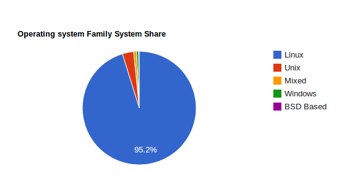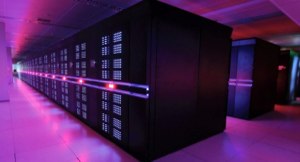Linux’s many strengths are undeniable in numerous aspects of computing today, but if there’s one area in which its domination tends to continue virtually unchallenged, it’s supercomputing.
Last November’s Top500 list was a perfect illustration of that ongoing reign — reporting as it did that a full 94 percent of the world’s top 500 supercomputers at the time ran Linux — and now the latest version of that list brings even more good news for Linux fans.
 Most notably, in the 41st Top500 list, which was announced Monday at the 2013 International Supercomputing Conference in Leipzig, Germany, Linux’s share of the world’s fastest machines had increased yet again by more than another percentage point to 95.2 percent.
Most notably, in the 41st Top500 list, which was announced Monday at the 2013 International Supercomputing Conference in Leipzig, Germany, Linux’s share of the world’s fastest machines had increased yet again by more than another percentage point to 95.2 percent.
“We see Linux continuing its domination of the Top500 supercomputer list with all of the top 10 and more than 90 percent of systems relying on clustered Linux,” Jay Lyman, a senior analyst for enterprise software at 451 Research, told Linux.com.
“Given Linux hardware, interconnect and application support, I don’t think this will change moving forward,” Lyman added.
An Unexpected Victory
Linux’s domination seems to be so well-established on these lists, in fact, that this latest statistic wasn’t otherwise remarked upon to any great extent in the new report.
Rather, the focus of much of the discussion this time was the list of winners themselves. Indeed, the machine in this list’s No. 1 spot is particularly interesting for a number of reasons.
 Tianhe-2, or Milky Way-2, wasn’t actually expected to be deployed for another two years. Making a splashy early debut, however, the powerful supercomputer — developed by China’s National University of Defense Technology — is now not only scheduled to be deployed by the end of the year, but it claimed the No. 1 spot in the latest Top500, putting China back at the top of the list once again.
Tianhe-2, or Milky Way-2, wasn’t actually expected to be deployed for another two years. Making a splashy early debut, however, the powerful supercomputer — developed by China’s National University of Defense Technology — is now not only scheduled to be deployed by the end of the year, but it claimed the No. 1 spot in the latest Top500, putting China back at the top of the list once again.
With a performance of 33.86 petaflop/s on the Linpack benchmark, Tianhe-2 has 16,000 nodes, each with two Intel Xeon IvyBridge processors and three Xeon Phi processors, for a combined total of 3,120,000 computing cores.
‘Mainly Chinese’
Tianhe-2’s victory marks the first time China has been in the No. 1 position on the list since November 2010, when Tianhe-1A was the top system. This latest achievement is particularly notable, however, because of Tianhe-2’s heavy reliance on home-grown technology.
“Most of the features of the system were developed in China, and they are only using Intel for the main compute part,” explained Top500 Editor Jack Dongarra, who toured the Tianhe-2 development facility in May. “That is, the interconnect, operating system, front-end processors and software are mainly Chinese.”
Tianhe-2’s leading position meant that several other contenders slipped a spot on the list.
Titan Slips to No. 2
Previous leader Titan, for instance — a Cray XK7 system installed at the U.S. Department of Energy’s Oak Ridge National Laboratory — is now ranked at No. 2. Titan achieved 17.59 petaflop/s on the Linpack benchmark using 261,632 of its Nvidia K20x accelerator cores.
Just as it was in the last ranking, Titan remains one of the most energy-efficient systems on the list, consuming a total of 8.21 MW and delivering 2,143 Mflops/W.
Now in the No. 3 spot, down from No. 2 last time, is Sequoia, an IBM BlueGene/Q system installed at DoE’s Lawrence Livermore National Laboratory. Sequoia was first delivered in 2011 and has achieved 17.17 petaflop/s on the Linpack benchmark using 1,572,864 cores.
Sequoia is also one of the most energy-efficient systems on the list, consuming a total of 7.84 MW and delivering 2,031.6 Mflops/W.
‘Healthy Competition’
Rounding out the top five, meanwhile, are Fujitsu’s “K computer” installed at Japan’s RIKEN Advanced Institute for Computational Science in fourth place with a performance of 10.51 Pflop/s on the Linpack benchmark using 705,024 SPARC64 processing cores, and Mira, another BlueGene/Q system installed at Argonne National Laboratory, whose 8.59 petaflop/s on the Linpack benchmark using 786,432 cores earned it the No. 5 rank.
“There is a healthy competition among the U.S., China, Japan, Germany and others to push system speed and performance of these supercomputer systems forward,” Lyman pointed out. “While these are not reflective of the systems we see in the enterprise today, they are an indicator of the scale and capability that is coming to the wider industry.”
The twice-yearly Top500 list is compiled by Dongarra along with Hans Meuer of the University of Mannheim and Lawrence Berkeley National Laboratory’s Erich Strohmaier and Horst Simon. Full details on the new report can be found on the Top500 site.


